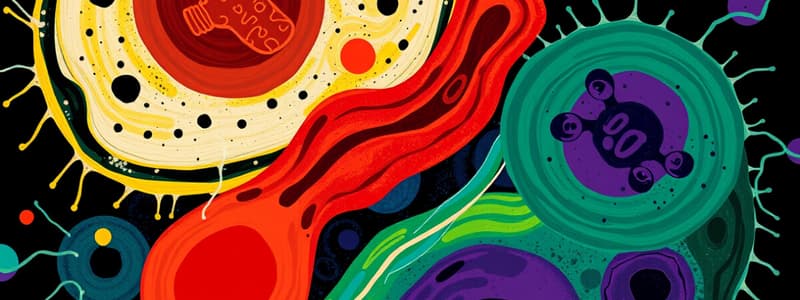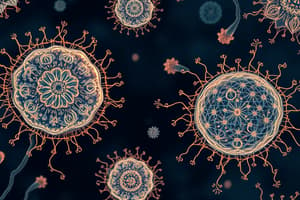Podcast
Questions and Answers
What are examples of prokaryotes?
What are examples of prokaryotes?
- Fungi
- Animals
- Plants
- Bacteria (correct)
What are eukaryotic cells?
What are eukaryotic cells?
Cells that are larger and more complex than prokaryotes.
What is cytoplasm?
What is cytoplasm?
The proportion of the cell outside of the nucleus.
What is the role of the cytoskeleton?
What is the role of the cytoskeleton?
What is the cell membrane?
What is the cell membrane?
What is diffusion?
What is diffusion?
When comparing two solutions, the solution with the greater concentration of solutes is called _____, while the solution with the lower concentration of solutes is called _____.
When comparing two solutions, the solution with the greater concentration of solutes is called _____, while the solution with the lower concentration of solutes is called _____.
What is endocytosis?
What is endocytosis?
What process do amoebas use to take in food and other material?
What process do amoebas use to take in food and other material?
What is cell specialization?
What is cell specialization?
What is facilitated diffusion?
What is facilitated diffusion?
What is osmosis?
What is osmosis?
What is active transport?
What is active transport?
Flashcards are hidden until you start studying
Study Notes
Cell Types
- Prokaryotes are simple cells, exemplified by bacteria.
- Eukaryote cells are larger and more complex, containing membrane-bound organelles.
Cell Structure
- Cytoplasm refers to the interior of the cell, excluding the nucleus.
- The cytoskeleton provides structural support to the cell and assists in its movement.
- All cells feature a cell membrane, a flexible barrier that encloses the cell.
Transport Mechanisms
- Diffusion involves the movement of particles from areas of higher concentration to lower concentration.
- In comparing solutions, a hypertonic solution has a higher concentration of solutes, while a hypotonic solution has a lower concentration.
- Endocytosis is the mechanism by which cells take in materials through the invagination of the cell membrane.
- Phagocytosis is a type of endocytosis used by amoebas to ingest food and other materials.
Cellular Functions
- Cell specialization allows for the differentiation of cells to perform distinct tasks efficiently.
- Facilitated diffusion utilizes protein channels to assist glucose in crossing the cell membrane.
- Osmosis is the specific diffusion of water across a selectively permeable membrane.
- Active transport is the energy-requiring process that moves materials across a membrane against their concentration gradient.
Studying That Suits You
Use AI to generate personalized quizzes and flashcards to suit your learning preferences.




